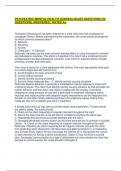Exam (elaborations)
PSYCHIATRIC MENTAL HEALTH NURSING NCLEX QUESTIONS (50 QUESTIONS) ANSWERED | RATED A+
- Course
- Institution
PSYCHIATRIC MENTAL HEALTH NURSING NCLEX QUESTIONS (50 QUESTIONS) ANSWERED | RATED A+ PSYCHIATRIC MENTAL HEALTH NURSING NCLEX QUESTIONS (50 QUESTIONS) ANSWERED | RATED A+ Flumazenil (Romazicon) has been ordered for a male client who has overdosed on oxazepam (Serax). Before administering the...
[Show more]



